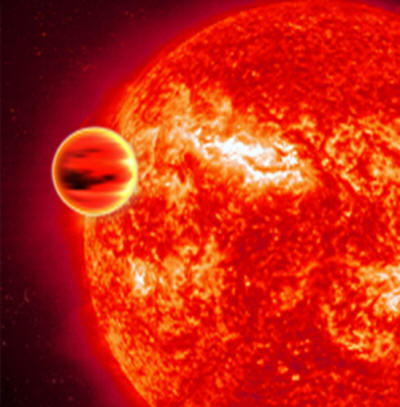|

by Stephen Smith
February 04, 2011
from
Thunderbolts Website
A recent
press release from the
Kepler
Space Telescope research team announced the discovery of an "alien
solar system" with six planets. That they are so near to the newly
named Kepler-11 star has caused some consternation, since they are
tightly aggregated in a single orbital plane.

Artist's impression
of an extrasolar planet
with many times the mass of Jupiter.
Credit: ESA/C.
Carreau
NASA launched Kepler (below video) on its three and a half year mission to search
for planets revolving around other stars, and it has found dozens of
them in a variety of sizes.
Astronomers have been investigating the
possibility that there are other stellar families outside of the
Solar System for many years, so Kepler was built to find planets
that are close to the size of Earth.
In 1756, Immanuel Kant proposed that the Solar System condensed out
of a dusty cloud of gas floating in space. As the "Nebular
Hypothesis" concludes, the cloud contracted because gravitational
attraction between particles caused them to clump together. As each
clump grew, even greater attractive force drew them all together
into a mass.
The mass attained so much gravity that it compressed into a small,
hot ball, rotating with the angular momentum contained in the
original cloud. It attracted more and more material into its
mounting gravitational field, until it finally ignited in a nuclear
fusion reaction, thereby giving birth to the Sun. If the hypothesis
is correct a similar, if not identical, process presumably takes
place in other nebular clouds.
The hypothesis has at least one fault:
it fails to explain how the
planets possess about 97% of the total angular momentum in the Solar
System when their combined mass is less than one-tenth of one per
cent of the Sun's mass.
Some astronomers have attempted to prop up
the theory by suggesting that the Sun has an undetected companion
star on a long, parabolic orbit that takes it beyond our
instruments.
Kepler-11's inner five planets all revolve closer than Mercury
orbits the Sun, posing a problem for the conventional explanation of
planet formation. However,
Electric Universe physicist Wal Thornhill
argues that a different view of stellar ignition and evolution
clears up the problem of planets packed in so tightly to their
parent star, as well as their angular momentum.
The plasma cosmogony hypothesis suggests that stars form when cosmic
Birkeland currents twist around one another, creating z-pinch
regions that compress plasma into a solid. Laboratory experiments
have shown that such compression zones are the most likely
candidates for star formation and not collapsing nebulae, which is
the eighteenth century theory to which astrophysicists still cling.
When stars are born, they are most likely under extreme electrical
stress. If such is the case, they will split into one or more
daughter stars, thereby equalizing their electrical potential.
Thornhill
writes:
"The fission process is repeated in further
electrical disturbances by flaring red dwarfs and gas giant planets
ejecting rocky and icy planets, moons, comets, asteroids and
meteorites.
Planetary systems may also be acquired over time by
electrical capture of independent interstellar bodies such as dim
brown dwarf stars. That seems the best explanation for our ‘fruit
salad’ of a solar system."
He
also argues that the longer a star lives, the more metal it will
accumulate:
"Intense plasma discharges at the stellar surface give
rise to star-shine. Those discharges synthesize 'metals' that
continually rain into the star's depths."
At some point, the star
ejects those metalized accumulations as large, ionized gas
giant-type planets.
Smaller, rocky objects might also calve from the
host star.
When it becomes possible to send probes to other star systems, they
will most likely find planets similar to those around our own Sun.
The electric forces that formed this planet most likely formed the
exoplanets, so it is expected that we will find Earth-like planets
eventually.
|

